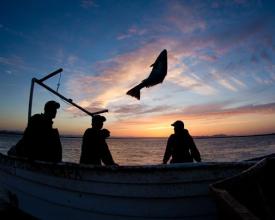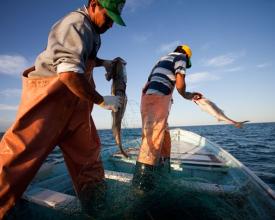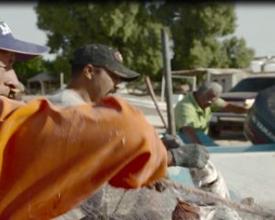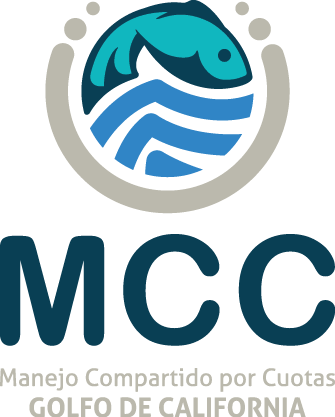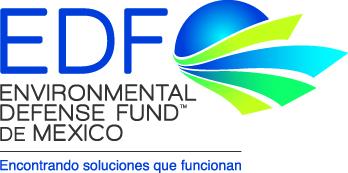
Catch Shares: Un marco para la pesca sostenible
Solución completa
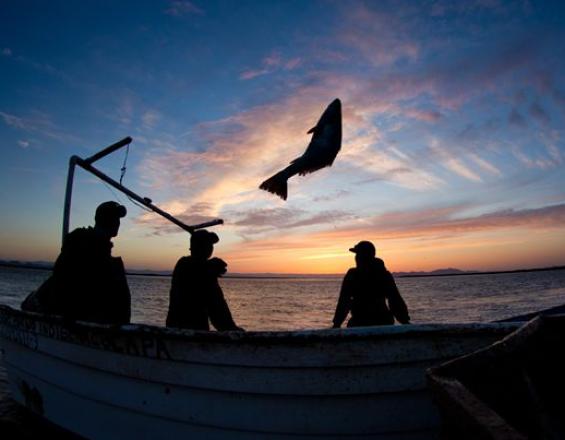
Pesca en el crepúsculo del Golfo de California
Carlos Aguilera
El Alto Golfo de California alberga diversas especies marinas, entre ellas la corvina endémica del Golfo, cuyo uso proporciona un medio de vida a más de 9.000 personas. El uso insostenible de los recursos ha llevado a la sobreexplotación de esta especie. El programa Catch Shares (MCC) es un marco para la gestión sostenible de la pesca, que permite reducir la sobrepesca y mejorar el bienestar económico de los pescadores que dependen de unos ecosistemas marinos sanos.
Última actualización: 30 Sep 2020
4952 Vistas
Contexto
Défis à relever
Pesca insostenible e ilegal, ecosistemas amenazados y disminución de los ingresos - Afluencia masiva de peces, que conduce a la sobreexplotación - Disminución de las poblaciones de peces, causada por la sobreexplotación - Efectos negativos en los ecosistemas por las capturas accesorias no intencionadas - Sobrecapitalización de las flotas - Escasa participación de los pescadores en los procesos de toma de decisiones y ejecución - Discrepancia entre las inversiones económicas y las destinadas a la conservación - Pesca ilegal
Ubicación
El Golfo de Santa Clara, México
América Central
América del Norte
Procesar
Bloques de construcción
Derechos de acceso a la pesca
Los derechos de acceso, como las cuotas individuales o los derechos de uso territorial (TURFS), delimitados sobre la base de resultados científicos y procesos participativos, ayudan a evitar la sobrepesca y a recuperar las poblaciones de peces. Garantizan a los pescadores una pesca estable a lo largo del tiempo y beneficios exclusivos de una gestión sostenible, incrementando su administración y cumplimiento.
Factores facilitadores
- Apoyo mediante legislación asociada - Establecimiento a largo plazo de derechos de acceso - Normas y reglas claramente definidas
Lección aprendida
Ejemplos a nivel internacional demuestran que con derechos de acceso: - Los pescadores manejan responsablemente sus recursos - La administración y planeación de las actividades pesqueras mejora en el corto, mediano y largo plazo En México existen ejemplos únicos en los que los derechos de acceso son acordados entre pescadores y autoridades de manera inusual: - Es necesario actuar con un marco jurídico claro y transparente que cuente con un marco legal para los derechos de acceso
Ciencia colaborativa
Una información precisa y actualizada es crucial para la gestión de los recursos. La formación de Grupos Técnicos permite la colaboración científica para la toma de decisiones. Estos grupos están formados por participantes de instituciones públicas y académicas que se reúnen periódicamente para compartir información relevante para la gestión de la pesquería.
Factores facilitadores
- Acceso a los datos públicos de pesca - Colaboración a través de reuniones de expertos - Mecanismos y normas claros para compartir y utilizar la información de diferentes fuentes y por diferentes instituciones - Funciones y responsabilidades claras para cada miembro del grupo de expertos - Análisis y no sólo difusión de la información - Información científica compartida con los responsables de la toma de decisiones - Compartir la información sobre la pesca con las comunidades para aumentar el sentido de propiedad y la participación en el seguimiento conjunto.
Lección aprendida
- La confianza entre las instituciones gubernamentales, los científicos y las organizaciones de la sociedad civil es clave para permitir el intercambio de información - La información actualizada sobre las pesquerías permite tomar mejores decisiones sobre las actividades de gestión, ayuda a recuperar o conservar las especies y a calcular con mayor precisión los niveles máximos de rendimiento sostenible y las asignaciones individuales - La participación de la comunidad en la recopilación de datos favorece la capacitación de los miembros de la comunidad y el establecimiento de una relación responsable con el recurso - Es importante publicar los resultados de cada investigación en la que haya participado la comunidad para crear transparencia, así como para motivarles a continuar en el seguimiento conjunto.
Participación y cogestión
Pescadores, autoridades pesqueras y medioambientales, científicos, compradores y ONG participan en todo el proceso de gestión, desde el diseño hasta la evaluación. A través de reuniones multipartitas y comités consultivos, se deciden los objetivos de una pesquería, se fijan las cuotas individuales y se abordan los retos comunes.
Factores facilitadores
- Las organizaciones de la sociedad civil bien arraigadas y aceptadas en la comunidad local ayudan a reunir a todos los participantes y facilitan el diálogo - Difusión de todos los resultados - Mecanismos jurídicos que promuevan la participación efectiva en la toma de decisiones a nivel federal - Inclusión de agentes no convencionales en el diálogo (por ejemplo, los consumidores).
Lección aprendida
- Una mayor participación requiere un mayor respeto por parte de todos los actores hacia los acuerdos alcanzados - Para elegir a los actores participantes es bueno tener un enfoque sistémico e identificar a aquellos -aunque no parezcan relevantes para los aspectos biológicos de la pesca- que son decisivos en su actividad como consumidores e intermediarios - Las comunidades que aumentan su nivel de confianza y conocimiento sobre el recurso que gestionan generan una comprensión más profunda de los cambios hacia una pesca sostenible - Actualmente no existe un marco de referencia para la formación y funcionamiento de los comités consultivos, En la actualidad no existe un marco de referencia para la formación y el funcionamiento de los comités consultivos, por lo que la inversión de tiempo y recursos corre a cargo de los participantes.
Asociaciones estratégicas no convencionales
Para fomentar la pesca sostenible es necesario crear asociaciones que promuevan el cambio de comportamiento, aunque se encuentren en extremos opuestos del mercado. Una asociación de pescadores y compradores aporta beneficios mutuos, como mejores precios y productos de mayor calidad. Esto incentiva a los pescadores a respetar los límites de capturas y las zonas de veda.
Factores facilitadores
- Definir objetivos: Qué se quiere conseguir y dónde - Encontrar objetivos comunes entre los socios - Identificar fortalezas, debilidades, capacidades y alcance propio de forma crítica y realista - Imparcialidad - Trabajar con diferentes actores sin distinción política o ideológica para alcanzar objetivos comunes - Comunicación fluida y continua entre todas las partes interesadas.
Lección aprendida
- Incluir a distintos actores -algunos con un impacto hasta ahora no reconocido- permitió identificar puntos focales que desencadenaron el primer paso importante del proyecto y que dieron a los participantes una idea de las posibilidades y el éxito - Una sola organización no puede hacerlo todo, se necesita la suma de esfuerzos y poderes para lograr resultados sólidos y a largo plazo - Si se es nuevo en un lugar, ayuda trabajar con actores conocidos en la comunidad para entender los valores, motivaciones e intereses de una pesquería y trazar objetivos comunes - La confianza es fundamental para establecer alianzas estratégicas. Hay que invertir tiempo en desarrollarlas y fortalecerlas, sobre todo cuando se establecen por primera vez - Una amplia red de alianzas estratégicas disminuye el riesgo de fracaso del proyecto. Depender de un único actor puede amenazar los resultados y la viabilidad a largo plazo de un sistema de gestión - Las alianzas permiten un mayor control sobre las acciones, el seguimiento y la evaluación en la consecución de los objetivos acordados
Impactos
Las comunidades gestionan sus recursos de forma más responsable, participan en la toma de decisiones y aplican la legislación La pesca regulada y limitada reduce sus costes de inversión en un 14%, aumenta los ingresos totales en un 8% y detiene las variaciones de precios en un 50% principalmente Derecho de acceso garantizado a los recursos pesqueros, limita la pesca y permite a los pescadores ser más selectivos, es decir, reducir las capturas accesorias no intencionadas Las capturas se reducen en un 40%, pero los precios pagados aumentan en un 22%, lo que mejora la relación entre volumen y valor.
Beneficiarios
pescadores artesanales e industriales, comunidades pesqueras, autoridades pesqueras locales y nacionales, consumidores, institutos de investigación, organizaciones de la sociedad civil, responsables legislativos y comunidades locales
Historia
Caos, ésa es la mejor manera de describir la pesca de curvina hace algunos años", dice Francisco Domínguez, pescador desde hace más de 40 años en el Golfo de Santa Clara. Cada año, entre febrero y mayo, las corvinas se reúnen en el delta del río Colorado para reproducirse en luna llena o nueva. En esa época, el mar se convierte en un hervidero de peces y las embarcaciones se lanzan a una carrera competitiva para capturarlas. "Entonces pescábamos sólo por pescar", recuerda Francisco. No había incentivos para disminuir las capturas, a pesar de la saturación del mercado y el desplome de los precios. Desde la implantación de la Catch Shares en 2012, esos días han quedado atrás. Ahora, los pescadores como Francisco tienen un acceso seguro a sus recursos, lo que les permite planificar con antelación, reducir costes y aumentar los ingresos manteniendo la cosecha pesquera en niveles sostenibles. Con Catch Shares, el caos ya no es la realidad de la pesquería de corvina: "Ahora tenemos más peces en el agua, más comida en el plato y una comunidad más próspera.
